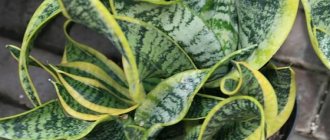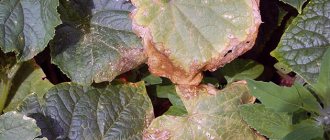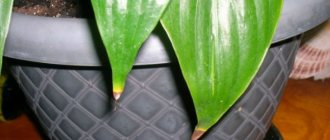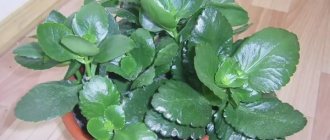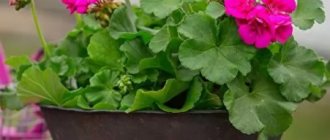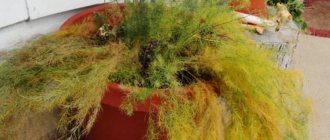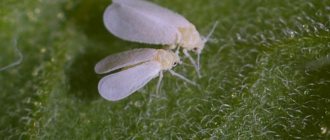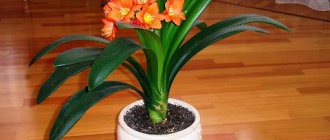The Sansevieria plant officially has another variant of the name - Sansevieria. Our people also call it mother-in-law's tongue and pike's tail. Someone compared this flower to a reptile and called it “snake skin”, “snake braid”, “snake plant”. The British saw in it a “leopard lily”, the Chinese - a “tail of a tiger orchid”, the Turks - a “pasha’s sword”, and the Brazilians even saw a “sword of St. George”. Surely there are many more original names, like “wolf’s tail”, “devil’s tongue” and the like, but this all only indicates that Sansevieria has settled near people for a long time. It has become so domestic and familiar that it is not always noticed, but it is a beautiful plant that brings great benefits to humans in response to minimal care. We will tell you in the article what conditions to create for the plant to grow and reproduce.
Origin and appearance of the plant
Sansevieria (Sansevieria) is a perennial evergreen plant of the asparagus family, a guest from the hot and dry, rocky regions of the tropical and subtropical zone of our planet. The harsh conditions of arid places made it very hardy: it learned to do without moisture for a long time and survive by storing it in the leaves.
The natural growing conditions of Sansevieria made the plant hardy
Under natural conditions, Sansevieria is distributed in India and the Indonesian Pacific Islands, Africa and the island of Madagascar. It also grows in the western hemisphere - in southern Florida.
The leaves of various species can be vertically erect or growing horizontally, green, yellowish or brown in color, with silver, white or yellow specks, stripes, patterns, sometimes bordered by a stripe along the edge of the leaf.
The plant does not have a separate trunk - the leaves grow from the rhizome. When flowering, Sansevieria throws out an arrow with white, sweet-smelling flowers. Mainly reproduces by root shoots.
In former times, fiber was obtained from the leaves of this plant, which was used to make bow strings. Since the beginning of the 20th century, the plant has become a popular house flower. There are more than 60 species and even more varieties derived from them.
The leaves of many indoor sansevieria can reach a height of more than 1 meter.
Ozonator and air washer with prickly tips: benefits and harms of sansevieria
If you remember that sansevieria is inedible, is a little prickly and does not experiment in this regard, the presence of the plant in the room will significantly affect the constant refreshment of the air due to the released oxygen. This is one of the most active room ozonizers, which also actively absorbs and neutralizes such dangerous substances as nitrogen oxide, benzene, formaldehyde and trichlorethylene. These substances are released into the air by various synthetic materials and products, which are sufficient in any apartment.
Sansevieria is used in African folk medicine. According to healers, the smoke produced by burning dry leaves relieves headaches. A decoction treats scabies and relieves itchy skin. And ground fresh leaves disinfect wounds and help with skin diseases.
Sansevieria leaves contain saponin. This substance has an irritating effect on the mucous membranes of the nose, mouth and eyes if the plant juice comes into contact with them. It does not cause irritation upon contact with skin. But in both cases it must be washed off with plenty of water. When the leaves are eaten (which happens - children and pets are careless), saponins cause nausea and vomiting. The sharp and hard tips of the leaves, which can be pricked, pose a certain danger.
It is necessary to limit access to the plant for children and pets.
Video: meet the “mother-in-law’s tongue” flower
Variety of species and varieties
Of course, this is a bold attempt to try to list all the varieties and varieties of this amazing plant in a short article. The uniqueness of the hybrids is manifested in the shape and color of the leaves. Stamina remains the same for all species. The original natural species that gave rise to the selection of varieties is Sansevieria three-striped (three-striped) .
Table: natural types of sansevieria
| Species name | Characteristic | Note |
| Sansevieria three-striped |
| The most common type. In room conditions it reaches 1 m in height or more. |
| Sansevieria cylindrica |
| A deep groove is visible on the leaves. |
| Sansevieria pickaxe | Forms rosettes of 2–3 leaves, the color is a calm shade of green with light grayish or greenish spots. The leaves have a red edge. | Some varieties may have entirely reddish or brown leaves. |
| Sansevieria liberia |
| Originating from tropical West Africa, the name is associated with the country of Liberia. |
| Sansevieria graceful, or graceful | Leaves are up to 30 cm long, pointed towards the apex. The color is gray-green, with brownish-beige or light gray transverse stripes. | The leaves form tubes at the ends. |
| Sansevieria duneri |
| Sometimes the number of leaves in a rosette reaches two dozen. |
| Sansevieria hyacinth | The leaves are lanceolate, collected in bunches of 2 to 4 pieces, width from 2–3 to 7 cm, tapering towards the base. The length of the leaves usually does not exceed 50 cm. | The usual flowering time is winter. The flowers are small, with a very pleasant smell. |
| Sansevieria large | The leaves are up to 15 cm wide, close to wide ovals in shape, without a pointed tip. The color is most often intense green with darker transverse stripes. | Originally from the tropics of Africa. It is not one of the tallest, its height is on average 40–60 cm, but due to the width and apparent massiveness of the leaves it gives the impression of being solid and “big”. |
Recommended timing of the procedure
To get a new green pet, it is better to choose spring - the most favorable time of year for the propagation of many crops, including sansevieria. This is due to the accelerated pace of all metabolic processes in plants, therefore, the formation of roots will be more active and efficient.
Considering the unpretentiousness of “mother-in-law’s tongue,” it is quite possible to propagate it at any other time of the year. This is especially true for situations of saving an evergreen perennial, when the pot fell and the flower was damaged, it was attacked by diseases or pests, and the root system began to rot.
If you propagate a flower in winter, it may not take root due to slow metabolic processes.
Sansevieria transplant
For normal growth and flowering of the plant, a fairly tight pot is needed. Therefore, transplantation is carried out only as needed, approximately once every 2–3 years.
Transplantation is rarely carried out, only when the roots become cramped in the pot
It should be remembered: the root system of Sansevieria is so powerful that when the entire volume of soil in the pot is occupied by roots, they either tear the pot or begin to bulge upward. This will be a signal that it is time to replant the sansevieria.
What kind of soil and pot are needed?
The soil for sansevieria should be moderately sandy, well permeable to water and air. The classic formula: “leaf soil: turf soil: sand = 1:1:2.” Purchased soil is quite suitable for cacti and succulents . It is advisable to add sand, pebbles and a little clay to it. A prerequisite is the presence of a strong drainage layer at the bottom of the pot (for example, pebbles or expanded clay balls). It should occupy at least 1/4 of the volume of the pot.
The pot needs to be deep, 2–3 cm wider than before. For vertically growing varieties, it is better to take massive clay pots that provide stability for long, heavy leaves.
Important! When transplanting a plant into a new pot, you should tie it to a support while rooting and compacting the soil, since the leaves can overhang and tear the plant out of the ground.
Transshipment with replacement of land
Step by step description:
- Take a pot slightly wider than before, add layers of drainage and then moist soil.
- Water the plant well. After a while, remove it from the old pot, holding it by the leaves at the base.
- Remove old soil from the roots, being careful not to damage them.
- Place the plant in the center of the new container, add soil mixture until the roots are completely covered. Compact it.
- For the next 2 days, keep the plant in the shade and do not water: this will allow the roots to begin to grow into the soil.
Important! When transplanting a plant into a new pot, you should tie it to a support while rooting and compacting the soil, since long and heavy leaves can overwhelm and tear the plant out of the ground.
Leaf cutting method
Propagate tall varieties of Sansevieria using leaf cuttings. Please keep in mind that variegated varieties lose their species characteristics when the leaves are divided. The leaves of the new plant will be uniform in color and without stripes or inclusions.
- For propagation, select a large, strong leaf. Cut it into several parts and air dry for 24 hours. The length of each segment of the cut sheet must be at least 4 centimeters. The main thing is to remember where the bottom of the sheet is.
- After drying, immerse the lower part of the leaf segments by a third in wet sand, or in water.
- To make the rooting process faster, cover the container with the sowing with glass. Place it in a warm and well-lit place.
- Ventilate this greenhouse once a day, but it is better to water it through a tray.
Be patient and wait for a new shoot to emerge from the sand.
Experienced gardeners have learned to partially preserve the maternal properties of variegated sansevieria when propagating by leaf. However, this is a very troublesome task and requires skill:
- Using a scalpel, remove the green part from the cutting leaf.
- Plant the “operated” leaf so that only the surface of the light edging comes into contact with the soil. Thus, the roots sprout precisely from the light part of the leaf and thereby retain the maternal properties.
With careful care when propagating sansevieria by leaf, only after 3-4 months you will see the first young shoot. Agree, not all home plant lovers will like this propagation method.
Proper care - water less?
If we remember the harsh conditions of the natural growth of sansevieria, it becomes clear that this is one of the most unpretentious plants, capable of withstanding significant temperature changes, varying light levels and drought.
Important! The only problem for a plant during care can be excessive watering and water getting into the center of the leaf rosettes (especially in winter).
Nevertheless, there are comfortable, acceptable and unacceptable regimes for keeping sansevieria. In particular:
Choosing a pot
And a few more interesting observations. For sansevieria, which requires simple care and reproduction that is accessible to the grower, choose a heavy ceramic pot. It will hold pressure well from growing roots and provide reliable stability to a tall plant. As for the shape of the pot, it is best to opt for a wide and shallow option.
Not everyone knows that sansevieria can be grown outdoors in the warm season. At the same time, there is a possibility that it will bloom profusely. With the onset of stable warm weather, you can transplant it into open ground and keep it there until autumn.
Usually, by the beginning of autumn, new shoots grow next to the mother plant, which you can plant in separate pots. Staying in the open air significantly improves the appearance of sansevieria.
Olga Danilina
Reviews from flower growers
The houseplant Sansevieria (Piketail) has been living in my home for about 9 years.
I plucked off a small shoot from my mother-in-law, then we transplanted it into a jar, it took root and began to grow. Over time, the pike tail “demanded” a rather impressive pot, because it began to multiply by leaps and bounds. It became more and more crowded... My husband cannot stand its flowering (he is allergic). It is interesting that such droplets appear on the flowers of this plant. koala2014, Russia, Moscow
https://otzovik.com/review_2025984.html
This is the most unpretentious plant I have ever had.
There was a time when I constantly lived in 2 houses and sometimes did not appear in the apartment where Sansevieria was faithfully waiting for me for several months. All this time, no one watered the plant, and not only did it not bend, it also bloomed constantly. ilek87, Russia, Moscow
https://otzovik.com/review_2025984.html
I took this flower from a friend out of pity.
It stood on her window for several years and slowly just withered away. Then it was flooded - it was standing in water, then there was a drought in the ground. She was about to throw it away, and I picked it up. I changed the pot and soil and planted it, not counting on anything, three leaves. For several months the flower just sat in the ground, and after three or four months three leaves came out of the ground - my joy knew no bounds. Now this flower is two years old. <…> This summer I suddenly saw some dry white leaves on the windowsill. It turns out that my Pike tail is in full bloom. <…> The leaves of the pike tail are very dense, and therefore heavy. I can’t lift this flower pot. In addition to being beautiful, this flower is also useful. This flower is considered the best air purifier. A pike tail is absolutely necessary in a new apartment, in an apartment after renovation or after installing new furniture. The pike tail clears the air of chemicals and paint products. And where there is clean air, immunity is higher and people get sick less. gallin1234, Russia, Moscow
https://otzovik.com/review_1443895.html
Seed propagation
The method of propagating Sansevieria by seeds is less popular. The fact is that at home this plant blooms extremely rarely, and without this, as you know, the seeds do not appear. Plus, it’s almost impossible to see them on sale.
If you are lucky and have a pod with Sansevieria seeds, then germinating them will not be difficult.
- Dry the pod naturally.
- Remove seeds only immediately before planting.
- Plant them in damp sand, pressing slightly.
- Cover the container with the seeds with transparent film and place in a warm, bright place.
- Ventilate the greenhouse daily. Water the crops through a tray.
The first shoots may appear in a few months. Germination time depends on the quality of the seed. Pick up new shoots a month after they appear.
Video: caring for one of the most durable indoor flowers
You can often hear the opinion that Sansevieria will not dry out even if it is not watered for six months. But this is a living organism, therefore, it should still be given attention: the more return there will be on the part of the grateful green pet. This plant protects the cleanliness of the air in the house, saturates it with oxygen, and inhibits pathogenic microbes. These properties are now officially recognized by international scientific centers.
- Author: Evgeny Gridnev
Hello! My name is Evgeniy. My age is quite sufficient to have two higher educations and an academic degree, which allowed me to become, be and remain a biologist and ecologist. Rate this article:
- 5
- 4
- 3
- 2
- 1
(8 votes, average: 3.8 out of 5)
Share with your friends!
